Final report for FS17-304
Project Information
Statement of Problem
Our four cooperating farms together have produced 600,000 lbs of shrimp in a year. This year (2016) total production was 400,000 lbs. Production is lower because shrimp survival and corresponding production has decreased during the past 2 to 3 years. Several marine shrimp farms in Texas are experiencing similar problems as we have (Granvil Treece, Retired, Sea Grant; personal communication). If our survivals remain this low, we will not be able to remain in business. Shrimp survival has always been a concern of us farmers. We stock only specific pathogen free seed stock that are certified to be free of viruses and one bacterial disease that commonly affect farmed shrimp. Even so, baby shrimp are so small that they can succumb early in life without the farmer seeing the immediate effect.
During the past 3 years we have seen a decrease in survival of shrimp both at the post larval (baby) stage and most noticeably during the last 6 weeks before harvest. A limited number of shrimp have been evaluated histologically and found to contain moderate levels of pathogenic Vibrio bacteria that are well known to reduce production or kill shrimp at high infection rates. Vibrio is a common problem in Texas shrimp culture, but we have not seen obvious signs of disease before now in Alabama. Problems present themselves as a daily attrition of floating dead animals on the windward side of ponds. Once the mortality begins, it usually does not end until harvest. Sometimes there is more acute mortality that happens over a several day period. The acute mortality is almost always associated with heavy blooms of certain species of blue-green algae known to produce toxins that may affect shrimp if at sufficiently high concentration. Genera of Psuedoanabenna, Oscillatoria and Prymnesium, a golden algae, have been identified. These algae seem to release toxins as they die, because shrimp mortality usually occurs during partial or complete mortality of the algae. If shrimp are already weakened by a low level of Vibrio, then they are more likely to succumb to other environmental stressors such as phytotoxins.
We sell our shrimp fresh to individuals at the farm, restaurants, and retail stores. Some of us sell a large amount of our shrimp as a frozen processed product to a natural foods market. Most of our clientele desire chemical-free shrimp that have been raised locally without antibiotics and pesticides. Herbicides are available to limit the blooms of noxious algae, and possibly reduce the incidence of Vibrio infection. However, we require alternative, non-chemical ways to resolve our problems and be sustainable. The resolution of the problem will require an ecosystem approach, because shrimp health is directly impacted by pond environmental conditions.
The use of live biota, or probiotics, to confer a health benefit on target animals has been gaining traction in the aquaculture world. The probiotic usually is bacterial or other single celled organism such as yeast. We propose to use a mixture of three Bacillus species that are known to increase growth and survival in shrimp by direct consumption, but are also known to reduce organic loads in ponds by consuming organic matter. The mode of action is not absolutely known, but consumed bacteria tend to outcompete and inhibit growth of pathogenic bacteria, and stimulate the shrimp immunosystem. The reduction of organic matter in the pond environment is thought to limit substrate for pathogenic bacteria, as well as limit regions of low oxygen that might adversely affect shrimp. Observational data indicate that use of this probiotic material can also reduce the incidence of blue-green algae. Bacillus sp. has the great advantage of forming spores that can be dried and stored for later application. Upon hydration, the spores rapidly form bacteria to populate their environment.
These probiotics are routinely used in hatcheries and nurseries to limit disease incidence and promote growth, but tests for effectiveness in grow-out ponds are limited. Probiotics tend to be specific for various pathogens and environments, so effectiveness may not be equal across farms in different soil types and environments. We propose to test this probiotic on three farms in Alabama and one farm in northwest Florida in order to more robustly evaluate effectiveness. We will follow protocols that have observationally increased survival in similar environments. We do not expect the probiotics to eliminate our problems, but to decrease their severity. The cost of probiotic use would then be contrasted with increased production and income.
Approach and Methods
We used a probiotic product formulated by INVE Aquaculture that guarantees a live bacterial concentration of 5X105 colony forming units per gram (CFU/g). The probiotic, called Sanolife® Pro-W, is added as a dried product weekly to nursery tanks and ponds at a rate of 80 g/acre-meter of water. The product was dissolved in water and applied around the edges of ponds or behind an aerator that mixed the pond.
We intend to evaluate the effectiveness of probiotic on shrimp health, water quality and type and density of blue-green algae. The primary determinant was survival and growth of stocked shrimp, which depends directly on good shrimp health and a good growing environment. Shrimp health was evaluated by direct quantification of infection by pathogenic Vibrio sp. and by histological analysis of tissue for disease. Environmental conditions were evaluated by repeated measures of water for selected metabolites and algae.
Each farm had ponds treated with probiotics and other control ponds that were stocked with similar rates of shrimp, but to which no probiotics have been added. We will have a total of 10 treatment ponds and 10 control ponds among 3 farms. One farm, Greene Prairie Aquafarm, had 4 treatment and 4 control ponds. Gulf American Shrimp and Forkland Springs each had 3 treatment and 3 control ponds.
Samples of water from each treatment and control pond were evaluated for Vibrio sp. once a month starting at stocking. Each month, 10 shrimp from each treatment and control pond were evaluated for Vibrio sp. Twice during the season, once half way through in July, and the other just before harvest, 10 shrimp from each treatment and control pond were evaluated histologically for disease. Shrimp health evaluations were conducted by Dr. Susan Laramore at her lab at Harbor Branch Institute/Florida Atlantic University.
Water samples will be collected weekly from each of the treatment and control ponds to be analyzed for total ammonia and nitrite. These are metabolites that can harm shrimp if in too high a concentration. Water quality analyses were done in the laboratory of the Alabama Fish Farming Center near the Alabama shrimp farms, or on farm at Wood Fisheries. Early morning and late afternoon pH were measured in situ at 24 inches of depth in all study ponds once a week at Greene Prairie Aquafarm. Water at the other two farms was periodically spot checked for pH.
Phytoplankton (microscopic pond algae) samples were collected every other week from each treatment and control pond to be analyzed for type and relative quantity of blue-green algae. Algae evaluation were conducted by personnel at the Alabama Fish Farming Center with assistance by personnel at Auburn University School of Fisheries.
All farms recorded the following information concerning each treatment and control pond: number of shrimp stocked, total feed input, total number of shrimp harvested and total weight of shrimp harvested. Observations on mortalities and other pertinent information were kept throughout the production season.
Survival, yield, water chemistry, phytoplankton numbers, and shrimp health from cooperating farms were analyzed for significant differences between control ponds and those treated with probiotic.
Cooperators
- (Researcher)
Research
We used a probiotic product formulated by INVE Aquaculture that guarantees a live bacterial concentration of 5X105 colony forming units per gram (CFU/g). The probiotic, called Sanolife® Pro-W, is added as a dried product weekly to nursery tanks and ponds at a rate of 80 g/acre-meter of water. The product was dissolved in water and applied around the edges of ponds or behind an aerator that mixed the pond water.
Each farm had ponds treated with probiotics and other control ponds that were stocked with similar rates of shrimp, but to which no probiotics had been added. There were a total of 10 treatment ponds and 10 control ponds among 3 farms. One farm, Greene Prairie Aquafarm, had 4 treatment and 4 control ponds. Gulf American Shrimp and Forkland Springs each had 3 treatment and 3 control ponds.
Ponds were stocked with shrimp post-larvae (PLs) that had been transported from a hatchery in Florida and acclimated to pond water in tanks located on each farm. Stocking occurred the first part of May in ponds that had been filled with water several weeks ahead of time, and amended with potassium and magnesium. Application of the first dose of probiotic was made 3 to 4 days before stocking. After stocking, shrimp were fed twice daily and cared for until harvest began in September. By the end of October, all ponds were harvested to prevent mortality from cold snaps.
Samples of water from each treatment and control pond were evaluated for Vibrio sp. once a month starting at stocking. Each month, 10 shrimp from each treatment and control pond were evaluated for Vibrio sp. Twice during the season, once half way through in July, and the other just before harvest, 10 shrimp from each treatment and control pond were evaluated histologically for disease. Shrimp health evaluations were conducted by Dr. Susan Laramore at her lab at Harbor Branch Institute/Florida Atlantic University.
Water samples were collected weekly from each of the treatment and control ponds to be analyzed for total ammonia and nitrite. These are metabolites that can harm shrimp if in too high a concentration. Water quality analyses were done in the laboratory of the Alabama Fish Farming Center near the Alabama shrimp farms, or on farm at Wood Fisheries. Early morning and late afternoon pH were measured in situ at 24 inches of depth in all study ponds once a week at Greene Prairie Aquafarm. Water at the other two farms was periodically spot checked for pH.
Phytoplankton (microscopic pond algae) samples were collected every other week from each treatment and control pond to be analyzed for type and relative quantity of blue-green algae. Algae evaluation were conducted by personnel at the Alabama Fish Farming Center with assistance by personnel at Auburn University School of Fisheries.
All farms recorded the following information concerning each treatment and control pond: number of shrimp stocked, total feed input, total number of shrimp harvested and total weight of shrimp harvested. Observations on mortalities and other pertinent information were kept throughout the production season.
Information from cooperating farms, water chemistry, and shrimp health were analyzed for significant differences between control ponds and those treated with probiotic.
Water Chemistry
Selected water quality variables are summarized in Table 1. Mean temperatures across farms were between 29 and 30 ºC, which is slightly lower than other years. No temperature differences were detected across treated and control ponds. Salinity was typically low on all farms averaging 2.3 to 3.0 ppt at Greene Prairie Aquafarm, 4.5 at Forkland Springs and 3.9 at Gulf American Shrimp. Salinity among ponds at GPA often varies based on when ponds are filled and how much rainfall is retained. Although mean salinity was higher in probiotic ponds than control ponds at GPA, it was in the normal operating range for both treatments. There were no differences between treated and control ponds at the other farms.
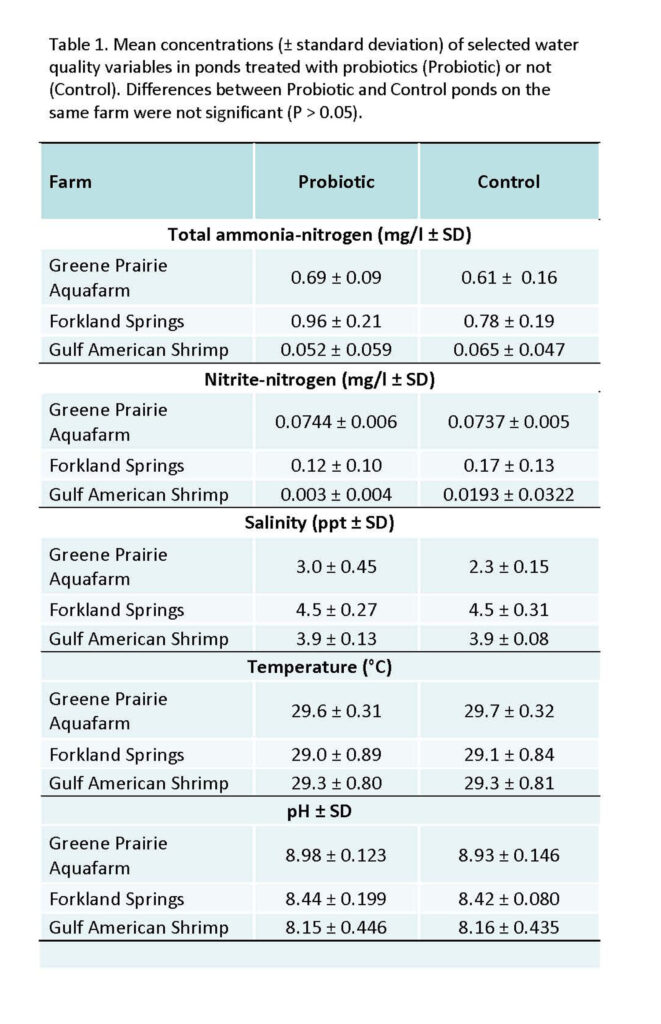
Total ammonia nitrogen and nitrite nitrogen remained within acceptable ranges with no significant differences between probiotic-treated and control ponds on any farm. Mean pH was similar for Alabama farms and there were no differences between treated and control ponds. However, several ponds at Greene Prairie, both treated and control ponds started the season with exceptionally high pH, rising higher than 10 and sometimes surpassing 10.3 (Figure 1). This occurred during the first three weeks after stocking when water was unusually clear and grass was growing in profusion. These ponds apparently suffered shrimp mortality, although exact numbers were unknown. Some of the ponds were subsequently restocked with 25 to 50% of the original quantity of shrimp. One of the ponds originally assigned to the probiotic treatment was changed out for another pond, because mortality was very high.
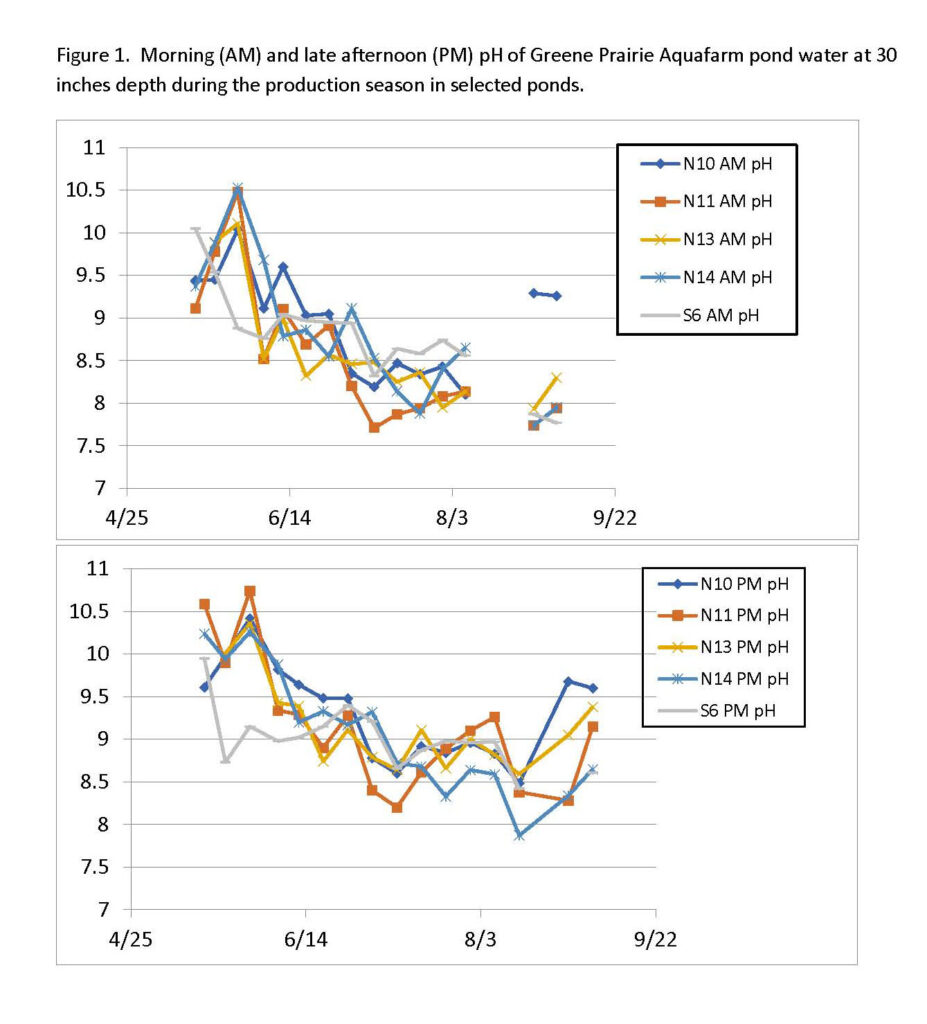
Algae
Anabaena, Microcystis, Oscillatoria, Euglena, and Prymnesium were detected in water samples. Table 2 summarizes selected genera found on the two Alabama farms. Algae were not identified and enumerated at the Florida farm.
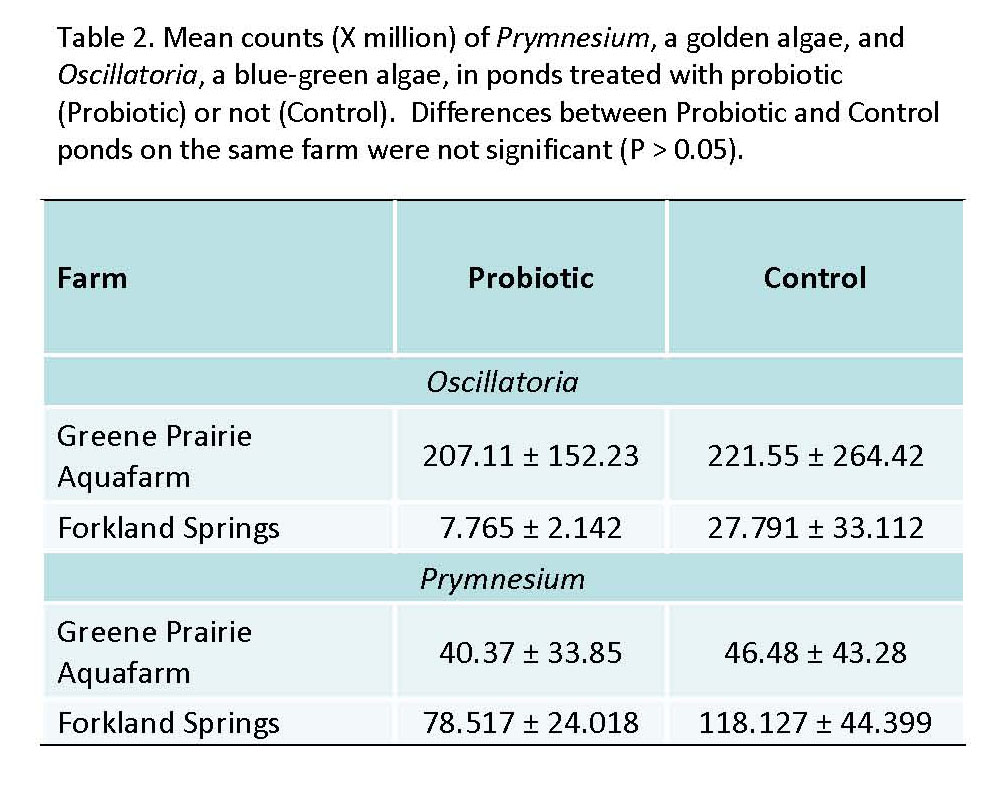
Prymnesium (golden algae) was present at both Alabama farms throughout most of the production season. This algae can release phytotoxins that have been associated with fish kills in low salinity rivers and reservoirs in Texas. Its effect on crustaceans is not well researched, but high concentrations have been observationally correlated with shrimp mortality in past years. There was no apparent shrimp mortality associated with the presence of Prymnesium this season.
Oscillatoria began to emerge in higher numbers toward the end of the production trial. Likely their occurrance was associated with higher temperatures and greater fertility that results from greater inputs of feed over the season. High concentrations of Oscillatoria have been associated with shrimp mortality in the past, but there was no apparent correlation this year between the presence of algae and shrimp survival. Colonial forms of blue-green algae such as Microcystis and Anabaena were also enumerated, but errors were made in the counting procedure, so their numbers were not included in this report.
No significant differences in total numbers of golden or blue-green algae were observed between control and probiotic ponds on either Alabama farm. The probiotic was advertised to decrease the occurrence of blue-green algae, but its application had no apparent effect on either blue-green or golden algae populations.
Shrimp Production
Survivals and yields of shrimp were low at all farms with, or without probiotic application (Table 3). As is normal, yield was directly dependent on survival. Numerical survival and yields were greater in probiotic versus control treatments at Greene Prairie and Gulf American farms, but the pond to pond variation was great, so the differences were not significant (P > 0.05). One pond in each of the probiotic and control treatments at Forkland Springs suffered complete mortality very early in the season, so they were eliminated from the study.

Shrimp Health
Viruses were not found in any shrimp samples from post-larval stage through harvest. Virus infections are a major killer of shrimp in world aquaculture, so their absence in our shrimp is heartening. We producers buy our shrimp young from hatcheries that are certified free of known viruses by state regulated testing.
Bacteria of pathogenic and non-pathogenic species were found in ponds and shrimp flesh. Highest Vibrio concentration in pond water were observed in early August at all locations and regardless of treatment, possibly because of higher temperatures (Figure 2). Vibrio in shrimp tail flesh was also greatest in August at all farms (Figure 3). Control ponds at Greene Prairie and Gulf American apparently had higher levels of Vibrio in pond water than treated ponds (Figure 3). However, shrimp in treated ponds apparently had greater concentrations of Vibrio than shrimp in control ponds. Therefore, there was an inverse relationship between Vibrio in pond water and Vibrio in shrimp flesh.
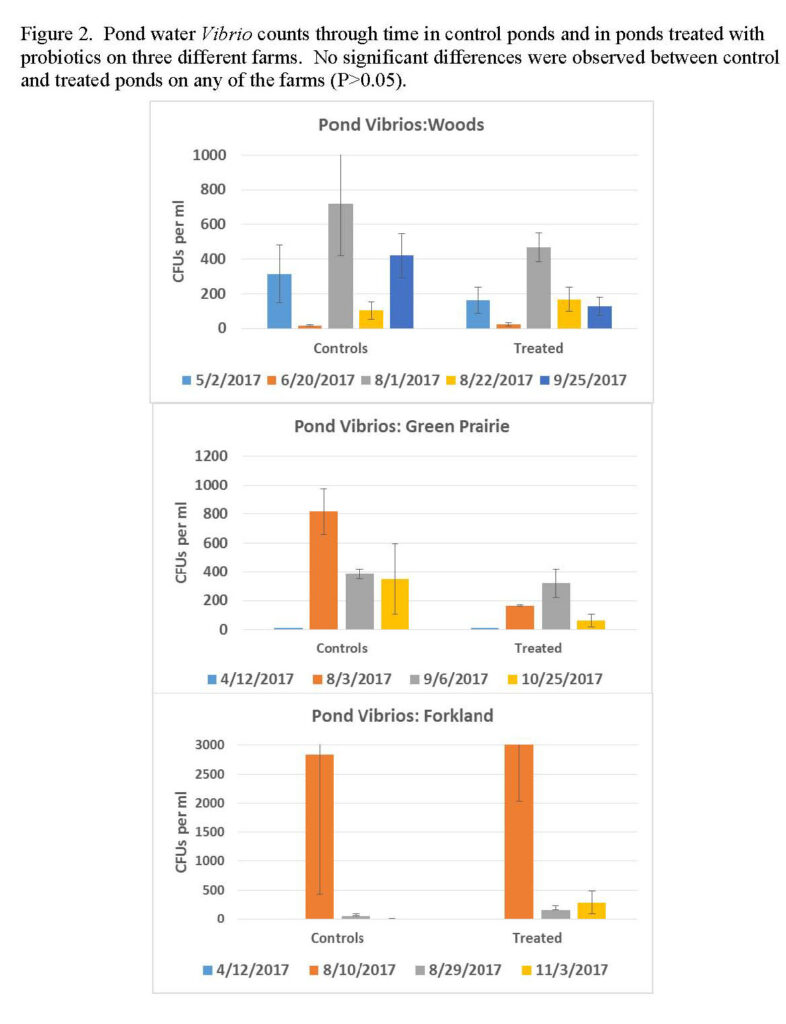
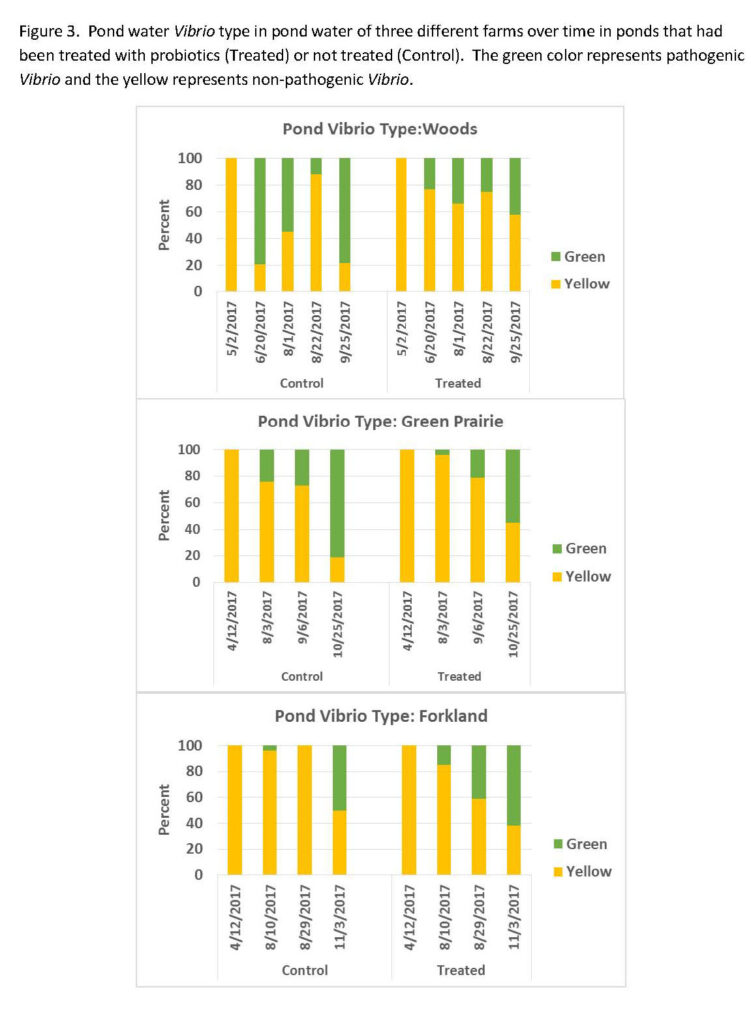
Not all Vibrio are pathogenic. An evaluation of proportion of pathogenic bacteria in pond water indicated that, in general, control ponds had a greater concentration of pathogenic Vibrios (green shade) than treated ponds (Figure 4).
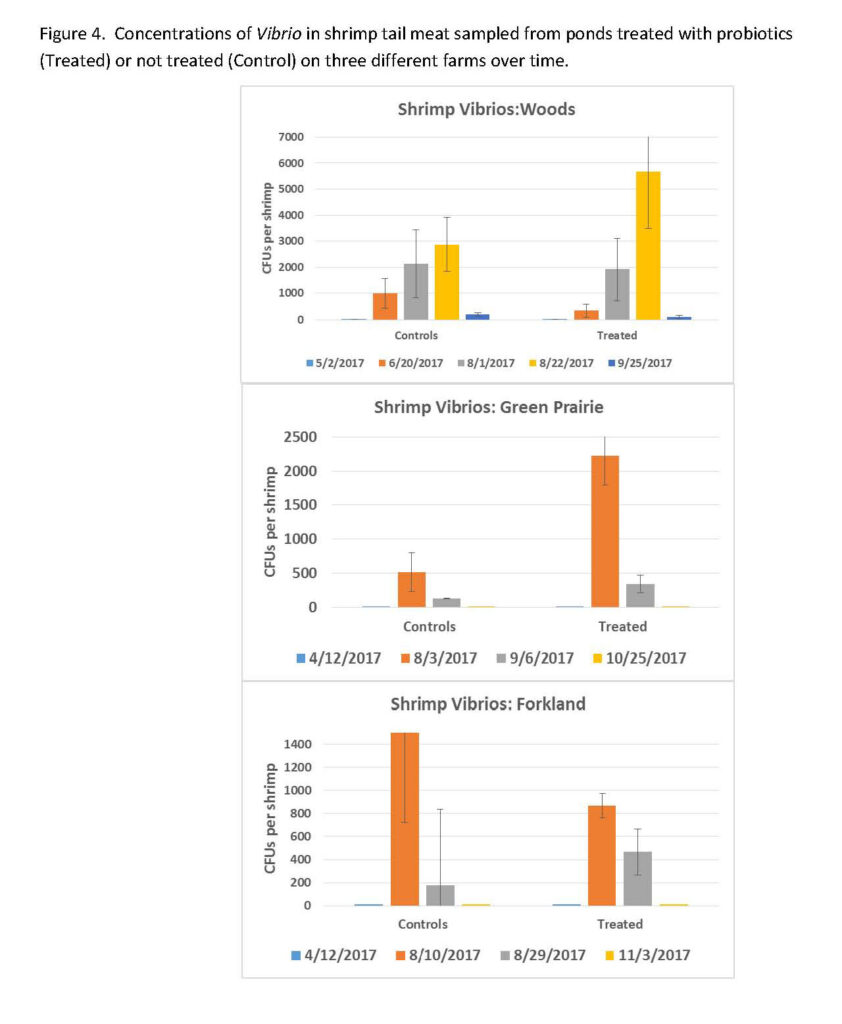
Histology
The histology of shrimp collected at the three farms is summarized by sampling date below.
Greene Prairie Aquafarm
- 8/3/2017: light bacterial necrosis and presence of worms in the hepatopancreas regardless of treatment (Figure 5)
- 10/25/2017: No real change from August
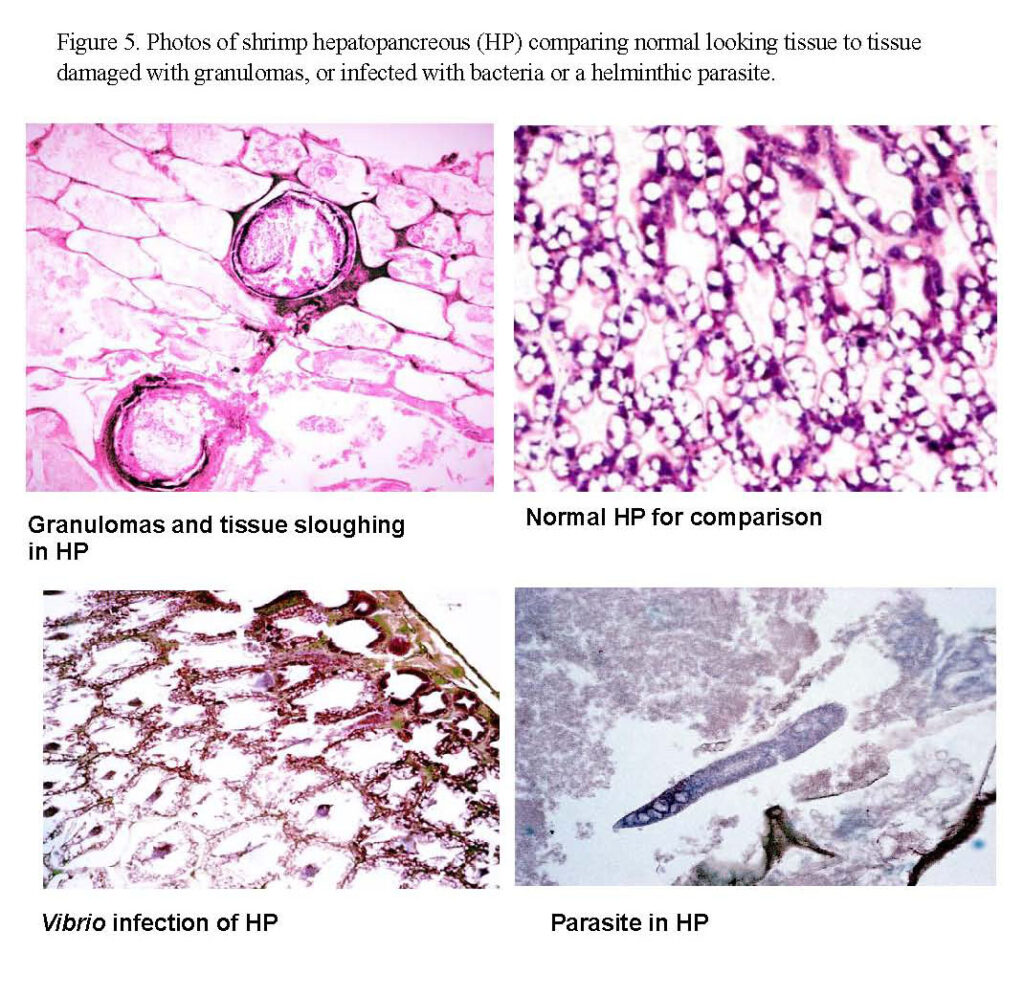
Forkland Springs Farm
- 8/3/2017: light to moderate bacterial necrosis regardless of treatment
- 11/5/2017: moderate to severe bacterial necrosis in treated ponds and light necrosis in control ponds
Gulf American Shrimp (shrimp mortality in numerous ponds in late August)
- 8/1/2017: Little pathology in ponds regardless of treatment
- 8/22/2017: Increased number of hemocytes (bacteria) but also increased number of lipid vacuoles in HP indicating possible algal toxicity problem
- 9/25/2017: Increased number of lipid vacuoles. Damaged columnar epithelial cells in intestinal tract and increased hemocytes, but little tissue damage indicating an acute rather than a chronic issue. Evidence points to an acute algal toxicity issue.
Histopathology varied among farms, and pond to pond variability was as prevalent as variability between treatments. Addition of probiotics to the pond appeared to have no impact on shrimp pathology.
Educational & Outreach Activities
Participation Summary:
This project by its very design was an outreach effort, because three shrimp farmers in the southeast were cooperating in this trial. Extension personnel from Auburn University and the Alabama Cooperative Extension System were additional cooperators. They have constant contact with colleagues across the nation. The information from this trial was reported at the World Aquaculture Society Annual Meeting in February 2018 in Las Vegas, NV. A meeting of the Alabama Inland Shrimp Producers Association was called in December 2017 to discuss the project findings. In attendance were Mark Godwin from Florida, 4 shrimp farmers from Alabama, several professors from Auburn University, AL, and other interested persons. There were 16 persons in all at the meeting (Appendix 1). Presentations were made by collaborating farmers and extension personnel. The results were discussed at length and some plans were made for follow-up research.Dec-7-2017_SARE-technical-meeting.Participant-List
List of Presentations
Roy LA, Teichert-Coddington D, Laramore S, Godwin M, Dahl S, James J, Whitis GN, Beck BH, Shoemaker CA. 2018. Commercial evaluation of a probiotic mixture (Sanolife Pro-W) to enhance survival, growth, and production of the Pacific white shrimp Litopenaeus vannamei cultured in inland ponds of west Alabama and Florida. Aquaculture America. Annual Meeting of the U.S. Aquaculture Society Las Vegas, Nevada. February 19-22, 2018.
Roy LA, Teichert-Coddington D, Dahl S, James J, Whitis GN, Beck BH, Shoemaker CA, Laramore S. 2018. Evaluating variable survival and production on inland low salinity shrimp farms using commercial research demonstrations. Alabama Fisheries Association. Auburn, Alabama. January 31, 2018.
Teichert-Coddington D, Murphy T, Arnold A, Godwin M, Roy L, Dahl S, James J, Whitis G, Beck B, Shoemaker C, Laramore S. 2017. On-levee tank and pond demonstration trials on shrimp farms in west Alabama and Florida. Review of On-farm Shrimp Trials 2017, Alabama Inland Shrimp Producer Association. Alabama Fish Farming Center, Greensboro, Alabama. December 7, 2017. (16 attendees)
Learning Outcomes
The objective of the project was to evaluate use of probiotics to increase survival and yields. We learned that probiotic applications did not cure our survival problems. However, the evaluation of shrimp health during the project taught us a lot about a subject we knew little about; i.e., viruses and bacterial infections were not the principal cause of mortality. The histology indicated that we should investigate more about the potential for algal toxins to harm our shrimp.
Project Outcomes
Probiotics appeared to decrease total numbers of Vibrios in the pond water and decrease the proportion of pathogenic bacteria in pond water. However, no correlated effect was seen in numbers of Vibrio in shrimp flesh. Probiotic use had no discernable effect on selected water quality variables or algae populations. Most importantly, probiotic treatment of ponds had no measurable effect on shrimp survival or shrimp production.
There was much variation among ponds for survival and yields regardless of treatment, and some of the variation seemed to be caused by factors like high pH that was unrelated to treatment. Observed mortality late in the season, particularly at Gulf American Shrimp, appeared to be caused by algal toxicity also unrelated to treatment. It is possible that strong negative factors like high pH and algal toxicity override and obscure the more moderate effects of probiotics on shrimp production. The strong negative effects must be first ameliorated, and then the use of probiotics might become effective. Until then, the cost of applying probiotics is unwarranted.
During the last 3 years there have been high levels of Oscillatoria present during “late term mortality” events. In this study, the histology of shrimp and the enumeration of Oscillatoria, a known producer of toxins, suggests that toxic algae merits further investigation particularly late in the season. Quantification of known toxins and correlation with algal biomass seems essential.
All three farms suffered high mortality. Pond water and shrimp flesh were monitored for viruses and Vibrio. No viruses were detected. Vibrio was detected in water and shrimp flesh, but without an obvious correlation to incidence of mortality. At Greene Prairie Aquafarm, most mortality occurred early in the season when Vibrio populations were low, probably because of unusually high pH. Mortality at Forkland Springs also occurred early without apparent reason. Most mortality at Gulf American occurred during the last month of production when Vibrio was low in pond water and shrimp flesh. However, histology indicated tissue damage consistent with toxins probably produced by blue-green algae. While Vibrio may not have been directly responsible for late term mortality, higher Vibrio levels in ponds and shrimp in August (prior to the occurrence of mortalities) may have weakened the shrimp to make them more susceptible to other stressors like toxic algal blooms.